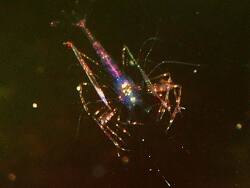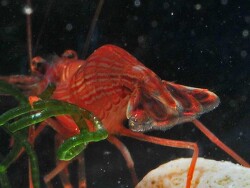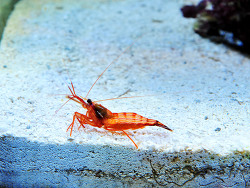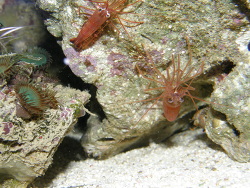Info
Lysmata boggessi, Rhyne & Lin, 2006
From Manuela Kruppas:
We ordered four Lysmata wurdemanni to combat our glass lice.
When Robert came home with our delivery, the difference was not yet noticeable, as the animals were still extremely pale at that time.
During the long acclimatization phase, the animals slowly developed their first red longitudinal stripes, for which the Wurdemanni shrimp is known.
In my aquarium, however, the markings on my shrimps continued to develop. Suddenly, in addition to the red longitudinal stripes, there were also red horizontal stripes and, in some animals, short dark stripes in the tail pattern.
The supposed identification revealed that it was a Lysmata shrimp, namely Lysmata rathbunae.
However, as Ruedi Furter discovered in 2007, this information is also incorrect.
Following a revision, the correct name is now Lysmata boggessi.
It is interesting how the name has changed over the years, but the purpose of the shrimp always remains the same, namely to destroy the much disliked glass lice.
Lysmata rathbunae is very light-colored and hardly common in our aquariums.
Most of the glass rose shrimps available are probably either Lysmata wurdemanni or Lysmata boggessi.
A very easy to keep shrimp species that does not live as hidden as the emperor shrimp.
It likes to hang out under overhanging stones.
The water quality should always be good.
Often occurs more in temperate waters than in tropical waters, but can also be kept well there.
Food: Lysmata boggessi and Lysmata wurdemanni eat glass roses - Exaiptasia diaphana!
If sufficient frozen food is offered, then glass lilies are not usually eaten!
All frozen food is readily accepted.
The shrimp carries yellow eggs.
Breeding information:
2 - 3 mm at birth - fresh Artemia nauplii as food
5 - 8 mm after 14 days - as food fresh Artemia nauplii
10 - 12 mm after 21 days
The best breeding results are achieved by keeping them in a larval gyre with a constant laminar flow.
The transformation from larva to shrimp takes between 33 and 38 days, depending on the water temperature.
The size of the shrimp after the transformation is 12 mm and the color is slightly reddish.
The water temperature influences the spawning period (with a difference of 1°C, for example, the difference can be ± 2-3 days) and, in the case of gonochoristic (separate-sex) fish or shrimps, the sex. If the temperature is below the usual regional temperature, mainly female larvae will hatch from the clutch, above this temperature mainly male larvae will hatch. Furthermore, the aquarium conditions (e.g. light duration, density) can also influence the sex.
The spawning size or the number of larvae depends on several factors - age and condition of the parents, water conditions, food, stress factors.
From Manuela Kruppas:
We ordered four Lysmata wurdemanni to combat our glass lice.
When Robert came home with our delivery, the difference was not yet noticeable, as the animals were still extremely pale at that time.
During the long acclimatization phase, the animals slowly developed their first red longitudinal stripes, for which the Wurdemanni shrimp is known.
In my aquarium, however, the markings on my shrimps continued to develop. Suddenly, in addition to the red longitudinal stripes, there were also red horizontal stripes and, in some animals, short dark stripes in the tail pattern.
The supposed identification revealed that it was a Lysmata shrimp, namely Lysmata rathbunae.
However, as Ruedi Furter discovered in 2007, this information is also incorrect.
Following a revision, the correct name is now Lysmata boggessi.
It is interesting how the name has changed over the years, but the purpose of the shrimp always remains the same, namely to destroy the much disliked glass lice.
Lysmata rathbunae is very light-colored and hardly common in our aquariums.
Most of the glass rose shrimps available are probably either Lysmata wurdemanni or Lysmata boggessi.
A very easy to keep shrimp species that does not live as hidden as the emperor shrimp.
It likes to hang out under overhanging stones.
The water quality should always be good.
Often occurs more in temperate waters than in tropical waters, but can also be kept well there.
Food: Lysmata boggessi and Lysmata wurdemanni eat glass roses - Exaiptasia diaphana!
If sufficient frozen food is offered, then glass lilies are not usually eaten!
All frozen food is readily accepted.
The shrimp carries yellow eggs.
Breeding information:
2 - 3 mm at birth - fresh Artemia nauplii as food
5 - 8 mm after 14 days - as food fresh Artemia nauplii
10 - 12 mm after 21 days
The best breeding results are achieved by keeping them in a larval gyre with a constant laminar flow.
The transformation from larva to shrimp takes between 33 and 38 days, depending on the water temperature.
The size of the shrimp after the transformation is 12 mm and the color is slightly reddish.
The water temperature influences the spawning period (with a difference of 1°C, for example, the difference can be ± 2-3 days) and, in the case of gonochoristic (separate-sex) fish or shrimps, the sex. If the temperature is below the usual regional temperature, mainly female larvae will hatch from the clutch, above this temperature mainly male larvae will hatch. Furthermore, the aquarium conditions (e.g. light duration, density) can also influence the sex.
The spawning size or the number of larvae depends on several factors - age and condition of the parents, water conditions, food, stress factors.







 BEASTIEPENDENT
BEASTIEPENDENT
















































